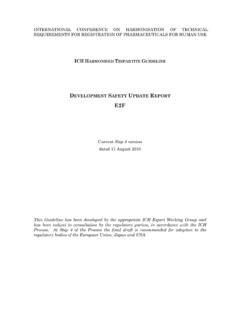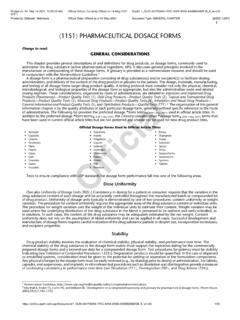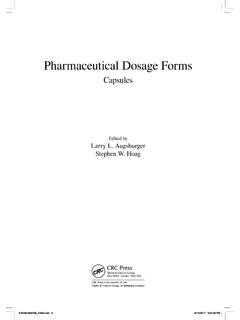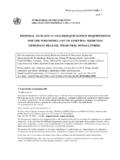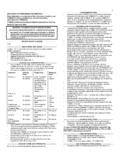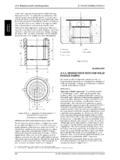Transcription of ICH HARMONISED TRIPARTITE GUIDELINE
1 INTERNATIONAL CONFERENCE ON HARMONISATION OF TECHNICAL REQUIREMENTS FOR REGISTRATION OF PHARMACEUTICALS FOR HUMAN USE ICH HARMONISED TRIPARTITE GUIDELINE DEVELOPMENT AND MANUFACTURE OF DRUG SUBSTANCES (CHEMICAL ENTITIES AND BIOTECHNOLOGICAL/BIOLOGICAL ENTITIES) Q11 Current Step 4 version dated 1 May 2012 This GUIDELINE has been developed by the appropriate ICH Expert Working Group and has been subject to consultation by the regulatory parties, in accordance with the ICH Process. At Step 4 of the Process the final draft is recommended for adoption to the regulatory bodies of the European Union, Japan and USA. Q11 Document History Code History Date Q11 Approval by the Steering Committee under Step 2 and release for public consultation. 19 May 2011 Current Step 4 version Code History Date Q11 Approval by the Steering Committee under Step 4 and recommendation for adoption to the three ICH regulatory bodies.
2 1 May 2012 i DEVELOPMENT AND MANUFACTURE OF DRUG SUBSTANCES (CHEMICAL ENTITIES AND BIOTECHNOLOGICAL/BIOLOGICAL ENTITIES) ICH HARMONISED TRIPARTITE GUIDELINE Having reached Step 4 of the ICH Process on 1 May 2012, this GUIDELINE is recommended for adoption to the three regulatory parties to ICH TABLE OF CONTENTS 1. INTRODUCTION .. 1 2. SCOPE .. 1 3. MANUFACTURING PROCESS DEVELOPMENT .. 2 General Principles .. 2 Drug Substance Quality Link to Drug Product .. 2 Process Development Tools .. 2 Approaches to Development .. 2 Drug Substance Critical Quality Attributes .. 3 Linking Material Attributes and Process Parameters to Drug Substance CQAs 4 Design Space .. 5 Submission of Manufacturing Process Development Information .. 5 Overall Process Development Summary .. 6 Drug Substance CQAs .. 6 Manufacturing Process History .. 6 Manufacturing Development Studies.
3 7 4. DESCRIPTION OF MANUFACTURING PROCESS AND PROCESS CONTROLS .. 7 5. SELECTION OF STARTING MATERIALS AND SOURCE MATERIALS .. 7 General Principles .. 7 Selection of Starting Materials for Synthetic Drug Substances .. 7 Selection of Starting Materials for Semi-Synthetic Drug Substances .. 8 Selection of Source and Starting Materials for Biotechnological/Biological Drug Substances .. 9 Submission of Information for Starting Material or Source Material .. 9 Justification of Starting Material Selection for Synthetic Drug Substances .. 9 Justification of Starting Material Selection for Semi-Synthetic Drug Substances .. 10 Qualification of Source or Starting Materials for Biotechnological/Biological Drug Substances .. 10 ii 6. CONTROL STRATEGY .. 10 General Principles .. 10 Approaches to Developing a Control Strategy .. 10 Considerations in Developing a Control Strategy.
4 11 Submission of Control Strategy Information .. 11 7. PROCESS VALIDATION/EVALUATION .. 12 General Principles .. 12 Principles Specific to Biotechnological/Biological Drug Substance .. 12 8. SUBMISSION OF MANUFACTURING PROCESS DEVELOPMENT AND RELATED INFORMATION IN COMMON TECHNICAL DOCUMENTS (CTD) FORMAT .. 13 Quality Risk Management and Process Development .. 13 Critical Quality Attributes (CQAs) .. 13 Design Space .. 13 Control Strategy .. 14 9. LIFECYCLE MANAGEMENT .. 14 10. ILLUSTRATIVE EXAMPLES .. 15 Example 1: Linking Material Attributes and Process Parameters to Drug Substance CQAs - Chemical Entity .. 15 Example 2: Use of Quality Risk Management to Support Lifecycle Management of Process Parameters .. 17 Example 3: Presentation of a Design Space for a Biotechnological Drug Substance Unit Operation .. 19 Example 4: Selecting an Appropriate Starting Material.
5 20 Example 5: Summary of Control Elements for select CQAs .. 21 11. GLOSSARY .. 25 1 DEVELOPMENT AND MANUFACTURE OF DRUG SUBSTANCES (CHEMICAL ENTITIES AND BIOTECHNOLOGICAL/BIOLOGICAL ENTITIES) Q11 1. Introduction This GUIDELINE describes approaches to developing and understanding the manufacturing process of the drug substance, and also provides guidance on what information should be provided in Module 3 of the Common Technical Document (CTD) Sections (ICH M4Q). It addresses aspects of development and manufacture that pertain to drug substance, including the presence of steps designed to reduce impurities. In addition, ICH Q11 provides further clarification on the principles and concepts described in ICH Guidelines on Pharmaceutical Development (Q8), Quality Risk Management (Q9) and Pharmaceutical Quality System (Q10) as they pertain to the development and manufacture of drug substance.
6 A company can choose to follow different approaches in developing a drug substance. For the purpose of this GUIDELINE , the terms traditional and enhanced are used to differentiate two possible approaches. In a traditional approach, set points and operating ranges for process parameters are defined and the drug substance control strategy is typically based on demonstration of process reproducibility and testing to meet established acceptance criteria. In an enhanced approach, risk management and scientific knowledge are used more extensively to identify and understand process parameters and unit operations that impact critical quality attributes (CQAs) and develop appropriate control strategies applicable over the lifecycle of the drug substance which may include the establishment of design space(s).
7 As discussed in ICH Q8 for drug product, a greater understanding of the drug substance and its manufacturing process can create the basis for more flexible regulatory approaches. The degree of regulatory flexibility is generally predicated on the level of relevant scientific knowledge provided in the application for marketing authorisation. Traditional and enhanced approaches are not mutually exclusive. A company can use either a traditional approach or an enhanced approach to drug substance development, or a combination of both. 2. Scope This GUIDELINE is applicable to drug substances as defined in the Scope sections of ICH Guidelines Q6A and Q6B, but might also be appropriate for other types of products following consultation with the appropriate regulatory authorities. It is particularly relevant to the preparation and organisation of the contents of Sections of Module 3 of the Common Technical Document (ICH M4Q).
8 The GUIDELINE does not apply to contents of submissions during the clinical research stages of drug development. Nevertheless, the development principles presented in this GUIDELINE are important to consider during the investigational stages. Regional requirements for post-approval changes are not covered by this GUIDELINE . Development and Manufacture of Drug Substances (Chemical Entities and Biotechnological/Biological Entities) 2 3. Manufacturing Process Development General Principles The goal of manufacturing process development for the drug substance is to establish a commercial manufacturing process capable of consistently producing drug substance of the intended quality. Drug Substance Quality Link to Drug Product The intended quality of the drug substance should be determined through consideration of its use in the drug product as well as from knowledge and understanding of its physical, chemical, biological, and microbiological properties or characteristics, which can influence the development of the drug product ( , the solubility of the drug substance can affect the choice of dosage form).
9 The Quality Target Product Profile (QTPP), potential CQAs of the drug product (as defined in ICH Q8) and previous experience from related products can help identify potential CQAs of the drug substance. Knowledge and understanding of the CQAs can evolve during the course of development. Process Development Tools Quality Risk Management (QRM, as described in ICH Q9) can be used in a variety of activities including assessing options for the design of the manufacturing process, assessing quality attributes and manufacturing process parameters, and increasing the assurance of routinely producing batches of the intended quality. Risk assessments can be carried out early in the development process and repeated as greater knowledge and understanding become available. Either formal or informal risk management tools, such as recognised tools or internal procedures, can be used.
10 Knowledge management (as described in ICH Q10) can also facilitate manufacturing process development. In this context, potential sources of information can include prior knowledge and development studies. Prior knowledge can include established biological, chemical and engineering principles, technical literature, and applied manufacturing experience. Data derived from relevant prior knowledge, including platform manufacturing (see Glossary) can be leveraged to support development of the commercial process and expedite scientific understanding. Approaches to Development ICH Q8 recognises that Strategies for product development vary from company to company and from product to product. The approach to, and extent of, development can also vary and should be outlined in the submission. These concepts apply equally to the development of the drug substance manufacturing process.
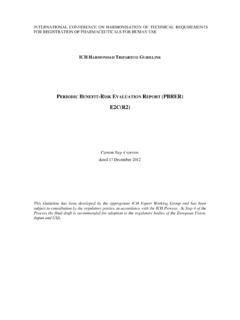
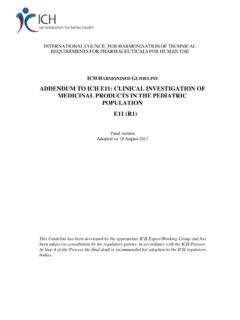
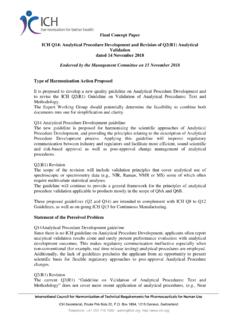
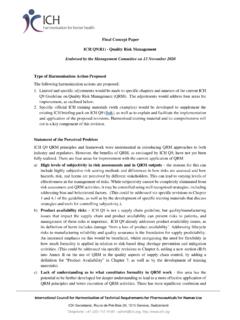
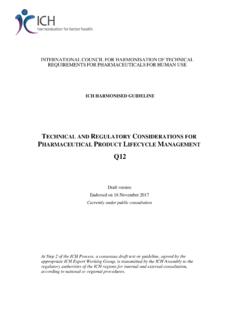
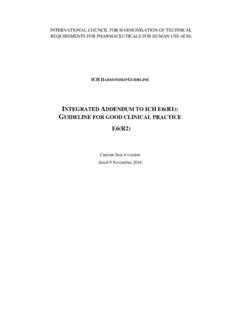
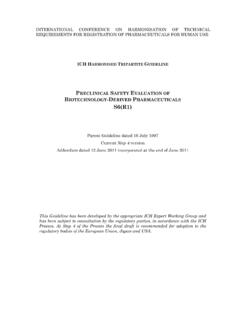
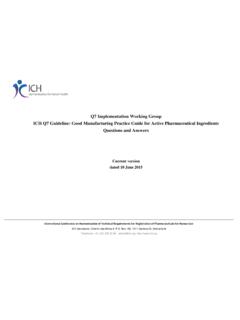
![[ICH E2F] [EXAMPLE DSUR – PHASE III INVESTIGATIONAL …](/cache/preview/e/7/a/2/e/6/3/0/thumb-e7a2e63043c4463724e748eb98faa3a7.jpg)
